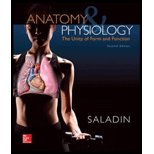
Concept explainers
Introduction:
Penis is the external genital organ in males. It is meant for intercourse with women and for ejecting the semen into the vagina. Penis is the tubular organ, and in males its size differs from age to age. The external genital organ in both sexes of humans differs greatly.
Answer to Problem 1TYR
Correct answer:
Clitoris is an external genital organ in females, which is a similar organ compared to that of the penis in males.
Therefore option (a) is correct.
Explanation of Solution
Justify reasons for the correct statement:
Clitoris is the external genital organ in females. It is similar to the penis in males. Clitoris is derived from the mesonephric duct in the embryo. It is the most sexually sensitive area for inducing orgasm, and it consists of corpus cavernosa connective tissue in the same way similar to the penis. Hence, clitoris is a comparable structure to that of the penis.
Option (a) is given as “Clitoris”
Clitoris is the female genital organ similar to the structure related to penis in males.
Hence, Option (a) is correct.
Justify reasons for the incorrect statements:
Option (b) is given as “Vagina”
Vagina is the tubular structure, which is meant for receiving the penis during intercourse and discharging menstrual fluid. It is entirely different from the male genital organ. Hence, it is wrong answer.
Option (c) is given as “The Vestibular bulbs”
The vestibular bulbs are a pair of subcutaneous erectile tissues. These tissues enclose the vagina and accompany a pair of greater vestibular glands. Both of these structures open into the vestibule, allowing the vulva to stay during intercourse. It is not comparable to that of the male’s penis. Hence, it is a wrong answer.
Option (d) is given as “The labia minora”
Labia minora is derived from the urogenital folds of the embryo. It is meant for sexual stimulation and expansion during child birth. Hence, it is a wrong answer.
Option (e) is given as “The prepuce”
Prepuce is an area at the anterior margin of the vestibule. It is meant for external sexual sensation like that of the foreskin of the penis, but it is not similar to that of the penis. Hence, it is wrong answer.
Hence, options (b), (c), (d), and (e) are incorrect.
Clitoris is the female genital organ that is similar to that of penis in males.
Want to see more full solutions like this?
Chapter 28 Solutions
Anatomy & Physiology: The Unity of Form and Function (Standalone Book)
- Briefly state the physical meaning of the electrocapillary equation (Lippman equation).arrow_forwardExplain in a small summary how: What genetic information can be obtained from a Punnet square? What genetic information cannot be determined from a Punnet square? Why might a Punnet Square be beneficial to understanding genetics/inheritance?arrow_forwardIn a small summary write down:arrow_forward
- Not part of a graded assignment, from a past midtermarrow_forwardNoggin mutation: The mouse, one of the phenotypic consequences of Noggin mutationis mispatterning of the spinal cord, in the posterior region of the mouse embryo, suchthat in the hindlimb region the more ventral fates are lost, and the dorsal Pax3 domain isexpanded. (this experiment is not in the lectures).a. Hypothesis for why: What would be your hypothesis for why the ventral fatesare lost and dorsal fates expanded? Include in your answer the words notochord,BMP, SHH and either (or both of) surface ectoderm or lateral plate mesodermarrow_forwardNot part of a graded assignment, from a past midtermarrow_forward
 Human Anatomy & Physiology (11th Edition)BiologyISBN:9780134580999Author:Elaine N. Marieb, Katja N. HoehnPublisher:PEARSON
Human Anatomy & Physiology (11th Edition)BiologyISBN:9780134580999Author:Elaine N. Marieb, Katja N. HoehnPublisher:PEARSON Biology 2eBiologyISBN:9781947172517Author:Matthew Douglas, Jung Choi, Mary Ann ClarkPublisher:OpenStax
Biology 2eBiologyISBN:9781947172517Author:Matthew Douglas, Jung Choi, Mary Ann ClarkPublisher:OpenStax Anatomy & PhysiologyBiologyISBN:9781259398629Author:McKinley, Michael P., O'loughlin, Valerie Dean, Bidle, Theresa StouterPublisher:Mcgraw Hill Education,
Anatomy & PhysiologyBiologyISBN:9781259398629Author:McKinley, Michael P., O'loughlin, Valerie Dean, Bidle, Theresa StouterPublisher:Mcgraw Hill Education, Molecular Biology of the Cell (Sixth Edition)BiologyISBN:9780815344322Author:Bruce Alberts, Alexander D. Johnson, Julian Lewis, David Morgan, Martin Raff, Keith Roberts, Peter WalterPublisher:W. W. Norton & Company
Molecular Biology of the Cell (Sixth Edition)BiologyISBN:9780815344322Author:Bruce Alberts, Alexander D. Johnson, Julian Lewis, David Morgan, Martin Raff, Keith Roberts, Peter WalterPublisher:W. W. Norton & Company Laboratory Manual For Human Anatomy & PhysiologyBiologyISBN:9781260159363Author:Martin, Terry R., Prentice-craver, CynthiaPublisher:McGraw-Hill Publishing Co.
Laboratory Manual For Human Anatomy & PhysiologyBiologyISBN:9781260159363Author:Martin, Terry R., Prentice-craver, CynthiaPublisher:McGraw-Hill Publishing Co. Inquiry Into Life (16th Edition)BiologyISBN:9781260231700Author:Sylvia S. Mader, Michael WindelspechtPublisher:McGraw Hill Education
Inquiry Into Life (16th Edition)BiologyISBN:9781260231700Author:Sylvia S. Mader, Michael WindelspechtPublisher:McGraw Hill Education





